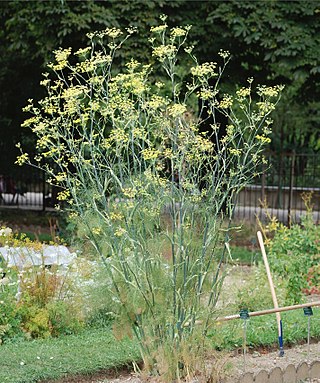
Fennel is a flowering plant species in the carrot family. It is a hardy, perennial herb with yellow flowers and feathery leaves. It is indigenous to the shores of the Mediterranean but has become widely naturalized in many parts of the world, especially on dry soils near the sea coast and on riverbanks.

Lomatium is a genus in the family Apiaceae. It consists of about 100 species. Its common names include biscuitroot, Indian parsley, and desert parsley. It is in the family Apiaceae and therefore related to many familiar edible species such as carrots and celery. Native to western Northern America and northern Mexico, some Lomatium species are extensively used by Native Americans in the inland Pacific Northwest as a staple food.
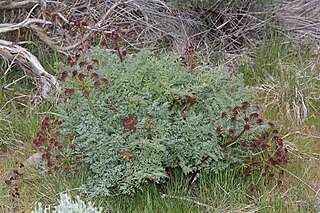
Lomatium dissectum is a species of flowering plant in the carrot family known by the common names fernleaf biscuitroot and fernleaf desert parsley. It is native to much of western North America, where it grows in varied habitat. It is found in the eastern slopes of the Cascade Range, Rocky Mountains, Klamath Mountains, eastern Transverse Ranges and the Sierra Nevada in California.
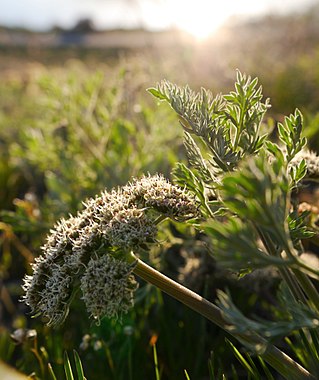
Lomatium macrocarpum is a perennial flowering plant in the carrot family known by the common names bigseed lomatium, biscuit root or bigseed biscuitroot. It is native to much of western North America, where it can be found in various types of habitat, including the grasslands of the Great Plains, and particularly in rocky areas. It is a spreading or erect perennial herb growing up to about half a meter long with hairy, gray-green herbage. The grayish basal leaves are up to about 24 centimetres (9.4 in) long and are intricately divided into many small, narrow segments. The inflorescence bears an umbel of yellowish, greenish, purplish, or white flowers, growing from a lateral stem. The fruit is a compressed, winged, round or oval disc up to about 2 cm long.
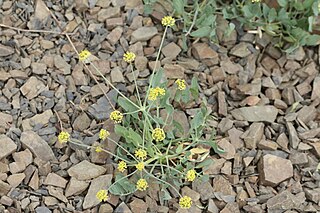
Lomatium nudicaule is a species of flowering plant in the carrot family known by the common names pestle lomatium, barestem biscuitroot, Indian celery and Indian consumption plant. It is native to western North America from British Columbia to California to Utah, where it is known from several habitat types, including forest and woodland. It is a perennial herb growing up to about 70 centimetres (28 in) tall from a thick taproot. It generally lacks a stem, the inflorescence and leaves emerging from ground level. The leaves are made up of many dull green, waxy lance-shaped leaflets each up to 9 cm long. The inflorescence is borne on a stout, leafless peduncle widening at the top where it blooms in an umbel of yellow or purplish flowers.

Penstemon parryi, the Parry's penstemon, Parry's beardtongue or desert penstemon, is a wildflower native to the Sonoran Desert of Southern Arizona and northern Mexico. It is a perennial that blooms in March and April. In the wild, plants flower in their second year. In cultivation, flowering is often achieved in the first year if seed is planted in the autumn.

Chorizanthe parryi is a species of flowering plant in the buckwheat family known by the common name Parry's spineflower and San Bernardino spineflower.
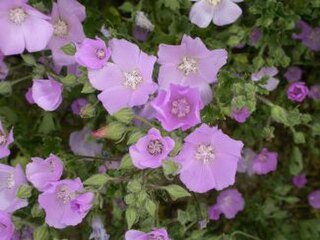
Eremalche parryi is a species of flowering plant in the mallow family known by the common name Parry's mallow.

Lomatium grayi, commonly known as Gray's biscuitroot, Gray's desert parsley, or pungent desert parsley, is a perennial herb of the family Apiaceae. It is native to Western Canada in British Columbia, and the Western United States, including from the Eastern Cascades and northeastern California to the Rocky Mountains.
Lomatium ciliolatum is a species of flowering plant in the carrot family known by the common name Yolla Bolly biscuitroot. It is endemic to California, where it is known from the mountain ranges adjacent to the north and south of the San Francisco Bay Area, at 300–600 feet, 1200–2100 m. It is often a member of the serpentine soils flora in woodland and chaparral habitat.
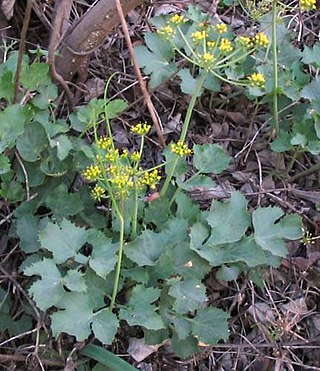
Lomatium lucidum is a species of flowering plant in the carrot family known by the common name shiny biscuitroot. It is native to coastal mountains and canyons of southern California and Baja California, where it is a member of the chaparral plant community, including recently burned areas. It is found in the eastern Transverse Ranges and the South Coast region.

Lomatium triternatum is a species of flowering plant in the carrot family known by the common name nineleaf biscuitroot. It is native to western North America from British Columbia to California to Colorado, where it grows in many types of habitat. It is a hairy perennial herb growing up to a meter tall from a taproot. The leaves emerge from the lower part of the stem. Each is generally divided into three leaflets which are each subdivided into three linear leaflike segments. The inflorescence is an umbel of yellow flowers, each cluster on a ray up to 10 centimeters long, altogether forming a flat formation of umbels.
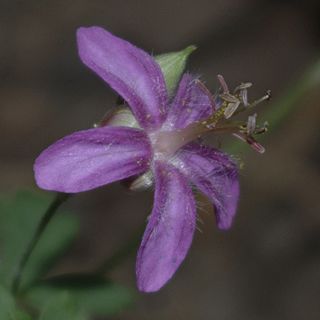
Geranium caespitosum, the purple cluster geranium or pineywoods geranium, is a perennial herb native to the western United States and northern Mexico. Its US distribution includes Arizona, Colorado, Nevada, New Mexico, Texas, Utah, and Wyoming.
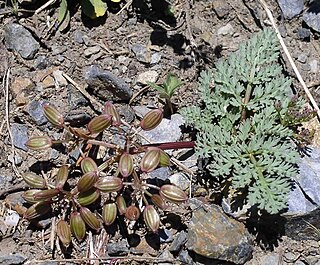
Lomatium erythrocarpum, known by the common name redfruit desertparsley, is a rare species of flowering plant in the carrot family. It is endemic to Oregon in the United States, where it is limited to a section of the Blue Mountains within Baker County.

Lomatium greenmanii is a rare species of flowering plant in the carrot family known by the common names Greenman's desertparsley and Greenman's biscuitroot. It is endemic to Oregon in the United States, where it is found only in the Wallowa Mountains of Wallowa County.

Lomatium latilobum is a species of flowering plant in the carrot family known by the common names Canyonlands lomatium and Canyonlands biscuitroot. It is native to an area straddling the border between Utah and Colorado in the United States, where several of its few occurrences are within Arches National Park and Colorado National Monument.

Astragalus amphioxys, common name crescent milkvetch, is a plant found in the American southwest, including the whole of Utah, the southeast part of Nevada, the north part of Arizona, the western part of Colorado, the northwestern part of New Mexico, and one county in Texas. It was first described by Asa Gray in 1878.
Gaillardia parryi, or Parry's blanketflower, is a North American species of flowering plant in the sunflower family. It is native to the southwestern United States. Some of the populations are inside Grand Canyon National Park, others in Grand Staircase–Escalante National Monument.
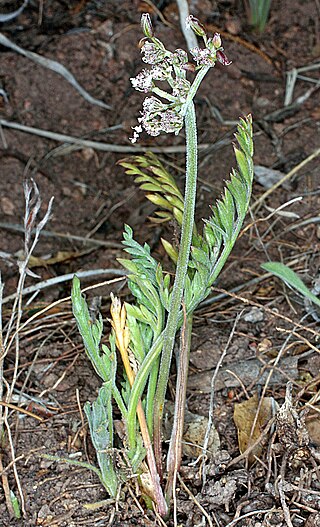
Lomatium orientale, commonly known as salt-and-pepper, eastern cous, eastern desert-parsley, eastern lomatium, white-flowered desert-parsley, oriental desert parsley or Northern Idaho biscuitroot, is a small spring blooming ephemeral plant. It grows in open habitats from the plains to foothills in western North America. It is known as one of the earliest blooming native flowers in its habitat. The species name, "orientale", is botanical Latin meaning "eastern".



















